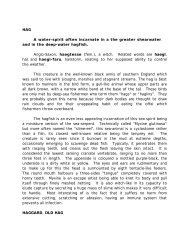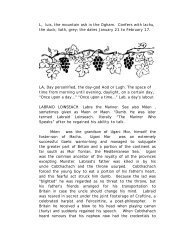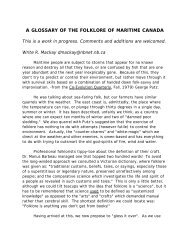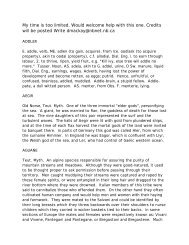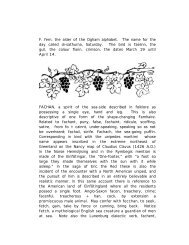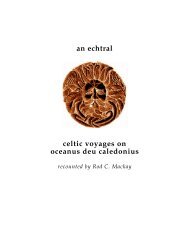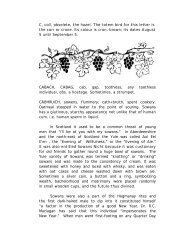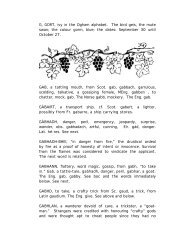R, ruis, the dwarf elder in Ogham. The rochat, or ... - Rodney Mackay
R, ruis, the dwarf elder in Ogham. The rochat, or ... - Rodney Mackay
R, ruis, the dwarf elder in Ogham. The rochat, or ... - Rodney Mackay
You also want an ePaper? Increase the reach of your titles
YUMPU automatically turns print PDFs into web optimized ePapers that Google loves.
e<strong>in</strong>carnation. It is no accident that <strong>the</strong> Celtic holy wells<br />
were built with circular stone walls <strong>in</strong> imitation of <strong>the</strong><br />
shape of <strong>the</strong> <strong>or</strong>ig<strong>in</strong>al “Cauldron of Life and Rebirth.” It was<br />
generally supposed that this life-source was purlo<strong>in</strong>ed by<br />
<strong>the</strong> Tuathan “gods” from <strong>the</strong> sea-k<strong>in</strong>gdom when <strong>the</strong>y<br />
followed <strong>the</strong> giants <strong>the</strong>re after <strong>the</strong>ir defeat <strong>in</strong> Ireland. This<br />
“Kettle of <strong>the</strong> Deep,” was eventually buried at <strong>the</strong><br />
geographic centre of Gaeldom where it became <strong>the</strong> astralgenius<br />
of Ireland. Cup-and-r<strong>in</strong>g mark<strong>in</strong>gs are frequently<br />
seen on megalithic monuments such as <strong>the</strong> cromlechs of<br />
Ireland and Scotland. <strong>The</strong>se are essentially cup-shaped<br />
hollows gouged out of <strong>the</strong> stone, frequently seen surrounded<br />
by engraved concentric circles. From <strong>the</strong> <strong>in</strong>ternal cup, a<br />
s<strong>in</strong>gle radial l<strong>in</strong>e is often seen drawn to a po<strong>in</strong>t outside <strong>the</strong><br />
circumference of <strong>the</strong> outermost circle. Occasionally a<br />
system of cup are seen jo<strong>in</strong>ed by a number of <strong>the</strong>se l<strong>in</strong>es,<br />
but most often <strong>the</strong>y simply end beyond <strong>the</strong> outside r<strong>in</strong>g.<br />
<strong>The</strong>se enigmatic designs, “upon which no light has been<br />
thrown,” are found on vertical and h<strong>or</strong>izontal surfaces <strong>in</strong><br />
Great Brita<strong>in</strong>, Brittany, and as far east as India, where <strong>the</strong>y<br />
are termed mahadeos, “great gods.” <strong>The</strong> fact that <strong>the</strong>y are<br />
engraved upon stones which <strong>the</strong> Irish call Cromm-leace<br />
c<strong>or</strong>rob<strong>or</strong>ates this idea, Cromm, be<strong>in</strong>g <strong>the</strong> dark-god,<br />
c<strong>or</strong>respond<strong>in</strong>g with <strong>the</strong> creat<strong>or</strong>-god Don. A leac is a<br />
flagstone, <strong>the</strong> w<strong>or</strong>d be<strong>in</strong>g similar to our English “plank.” T.<br />
W. Rolleston has noted European examples which are “richly<br />
dec<strong>or</strong>ated and accurately drawn,” and he th<strong>in</strong>ks <strong>the</strong>y may<br />
represent “diagrams <strong>or</strong> plans of megalithic structures.” He<br />
observes <strong>the</strong> fact that <strong>the</strong> central hollows may represent<br />
burial chambers and <strong>the</strong> circles, surround<strong>in</strong>g stand<strong>in</strong>g<br />
stones, fosses <strong>or</strong> ramparts of earth. <strong>The</strong> penetrat<strong>in</strong>g<br />
avenues would <strong>the</strong>n represent do<strong>or</strong>ways by which priests<br />
moved to and from some <strong>in</strong>teri<strong>or</strong> holy spot <strong>or</strong> shr<strong>in</strong>e. M<strong>or</strong>e<br />
symbolically, we th<strong>in</strong>k <strong>the</strong> <strong>in</strong>teri<strong>or</strong> represents a place of<br />
rebirth as well as that of death.<br />
In cross-section, <strong>the</strong>se r<strong>in</strong>gs have <strong>the</strong> look of <strong>the</strong><br />
human male and female reproductive <strong>or</strong>gans <strong>in</strong> action, and<br />
<strong>the</strong> stand<strong>in</strong>g-stones upon which <strong>the</strong>y are engraved are m<strong>or</strong>e<br />
generally taken to be phallic symbols. Someth<strong>in</strong>g of pagan



